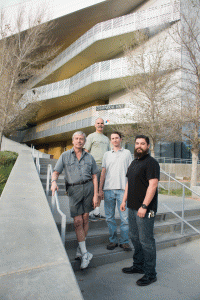Invisible Heroes Save Scientific Research Material During Power Outage

(L-R) William Krohmer, manager of technology services and safety; James Hogue, manager of biological collections;
Marc Harris, introductory biology lab technology; Marc Felix, stockroom supervisor. Photo by Lee Choo.
California State University, Northridge’s Department of Biology almost lost a substantial amount of delicate and rare research material during a power shutdown by the Los Angeles Department of Water and Power just before the start of the spring semester.
The shutdown involved the substations that distribute power to the entire campus and was conducted in coordination with CSUN Physical Plant Management (PPM) as part of regular maintenance.
The Department of Biology and PPM prepared for the shutdown weeks in advance, but an unforeseen wiring issue caused one of the main emergency generators to overpower two supply freezers, endangering the delicate research materials.
“The PPM Electrical Shop, in coordination with the Biology Department staff, really stepped up and saved all the materials,” said Jason Wang, director of PPM. “It was a major challenge, but they did an incredibly great job.”
According to Wang, a team of biology faculty and staff members started planning the provisions for the power shutdown two weeks in advance and provided PPM with detailed lists of critical equipment in the science buildings.
William Krohmer, manager of technical services and safety for the Biology Department, said the team had to determine which equipment had to be supplied with emergency power. The next step was to verify the number of emergency power outlets and which ones were already in use. Lastly, the team created the lists of critical equipment that needed emergency power.
“We have so much equipment and material that has to be kept at a proper temperature,” said Krohmer, who coordinated science department operations for the power shutdown. “We asked every faculty member what we needed to worry about and came up with 339 pieces of equipment.”
The team concluded that they wanted to take care of the biggest part of the project themselves and started planning how to supply 295 pieces of equipment with emergency power — acquiring supplies such as additional power cords and quad boxes. PPM provided help for the remaining 44 pieces.
“Chaparral Hall is a newer building and fortunately has a lot of emergency power outlets,” Krohmer said. “On the other hand, Eucalyptus Hall and Magnolia Hall are older and therefore do not have many of these outlets. These were the buildings we needed most help with.”
The most important items to secure were the freezers, which hold DNA, enzymes and other precious and rare research materials. Second on the priority list were the refrigerators that maintain chemicals, specimens and bacteria cultures.
“Some of the microbiological material can’t be found on Earth anymore,” Krohmer said.
At 12:15 a.m. the night of Jan. 16, the power was shut down and it was time for the emergency generators to kick in. Krohmer’s team had pre-staged all devices and connected everything once the power was off. All three generators turned on, but the one in Eucalyptus Hall failed.
“For some reason, it delivered 208 volts (instead of 110 volts) into two of our -80 degree freezers and overloaded them with power, which pretty much fried both freezers,” Krohmer said. “By the time we noticed the problem, they were already at -69 degrees. At -59 degrees, the organic material would have started to degrade.”
The team knew they needed to react quickly to save all the affected research materials. Krohmer and his team put together a system in which two people would carry dry ice containers to the basement freezers in Eucalyptus Hall, fill the containers with the precious materials, and then transport them to the functioning freezers on the third and fourth floors of Chaparral Hall across Lindley Avenue. The elevators didn’t work during the power outage, so the team had to carry the heavy containers up the basement stairs of Eucalyptus Hall and up the many flights of stairs of Chaparral Hall.
“We were lucky that the freezers in Chaparral Hall had some capacity. Otherwise, it could have been really bad,” Krohmer said.
Filled with about 100 pounds of research materials, the dry ice containers could barely be hefted up the stairs — the team used the handrails to slide the containers up to the building. By 3 a.m., Krohmer and his team had transferred all materials to the functioning freezers, taking about 14 trips. The team managed to save all materials without any known damage.
“One of the major components of the CSUN Biology program is our focus on hands-on research opportunities for students provided by our faculty,” said Krohmer. “Research is a critical activity that directly supports our teaching program, helps our faculty obtain grants and keeps students engaged. That’s why it was so important to save all these materials.”

 experience
experience